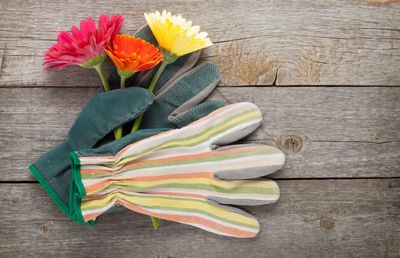Wearing Gloves in the Garden
While training a new guy at a garden center/landscape company where I worked, I suggested that he get a pair of good-quality gloves for the work we do. This man’s silly reply was, “Gloves are for girls, my hands are tough.” I could not actually force him to wear gloves if he didn’t want to, but I wondered to myself, how “tough” he would feel if his hands were full of rose or barberry thorns, or covered in oozing lesions from fungal skin infections picked up from certain plants or gardening materials. While many of my own gardening gloves are, indeed, made for women, with pretty floral patterns or girly colors, there are also just as many garden gloves on the market made specifically for men. Because I know wearing gloves in the garden will protect my hands from many things, I select them based on their durability, quality, and ability to handle tough jobs. If I find a pair of durable, good-quality garden gloves that happen to be cute and girly, that’s just an added bonus. I have also worked on tough jobs with men who have forgotten their gloves or had the wrong type of gloves for the task at hand, and who have not minded borrowing and wearing my “girly” floral printed gloves to avoid nasty thorns or skin abrasions. After all, when it’s a hot midsummer day and you’re dripping with sweat, caked with dirt, and have a tough job to finish, fashion and appearance are really the last things on your mind. Continue reading to learn about how to choose garden gloves for specific gardening tasks.
Selecting Gloves for Gardening
Gardeners wear gloves for many different reasons, such as:
keep hands and fingernails clean and dry avoid blisters and calluses prevent cuts and scrapes, or protect existing cuts and scrapes from infection protect against insect bites or stings protect skin from harmful chemicals like herbicides, pesticides, and fungicides. protection from fungal infections contracted by certain plants or gardening materials
While most people know that keeping wounds clean and protected can reduce the risk of infection, many people aren’t aware that they can actually get fungal infections from certain plants and soils. Sporotrichosis, or rose picker’s disease, is a fungal disease that causes nasty lesions and skin ulcers on people. This disease is oftentimes contracted from infected rose thorns or sphagnum peat moss. Wearing gloves in the garden can prevent this infection. When choosing garden gloves, the fit is, of course, important. If possible, try on the gloves to make sure they fit your hands snuggly, so they don’t slip off, but also not too tightly so as to restrict your ability to do the garden tasks you need to do. You should also select the right gloves for those intended garden tasks. Here are some different types of gardening gloves and their attributes:
Cloth Gloves – these are the most common and inexpensive gloves. They are usually made from knit jersey or cotton and are machine washable. Their main purpose is to keep hands clean and they offer very little protection to the hands, but they are cooler and breathable. Leather Gloves – these are more expensive but they are usually waterproof and protect the hands better from thorns, cuts, and scrapes. Rose gloves are usually made from leather. Rubber Coated Gloves – these are the best gloves for protecting hands while using chemicals such as herbicides, pesticides, and fungicides. However, hands can get pretty hot and sweaty in them, and if you have a latex allergy you should avoid them. Neoprene or Nitrile Gloves – these gloves are made from a synthetic rubber material so they can protect hands from chemicals and cuts and scrapes. They are also made to be breathable and flexible. However, nasty thorns can still puncture through them.
